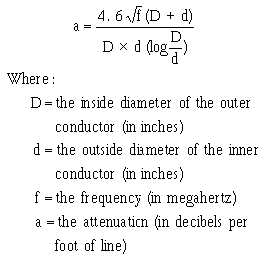4-11
Attenuation in a coaxial line in terms of decibels per foot can be determined by the following
formula:
As a technician, you need not be concerned with designing coaxial transmission lines. It is, however,
our feeling that you should be familiar with the parameters that go into making a transmission line. It can
readily be seen by the above formulas that transmission lines cannot be randomly selected without
consideration of system requirements. NAVSHIPS 0967-000-0140, EIMB, Reference Data, section 3,
lists the characteristics of most common transmission lines.
Q-5.
What factor has the greatest effect on the physical size of a coaxial cable?
Q-6.
Is the attenuation of a coaxial cable independent of frequency?
INTERMODULATION DISTORTION MEASUREMENTS
Intermodulation distortion occurs when two or more frequencies become mixed across a nonlinear
device. The resultants are the difference frequency and the sum frequency, both components of the
originals. Undesirable frequencies can be generated by a mixing of two discrete frequencies. Spurious
radiation, arising from close spacing of transmitter and receiver, is a prime source of an undesirable
frequency that can cause intermodulation distortion in an electronic circuit. This is particularly the case
when antenna couplers are employed. Cross modulation and parasitic generation (described in the next
section) are two other sources of undesirable frequencies that may cause intermodulation distortion.
Q-7.
What is the main cause of intermodulation distortion?
CROSS MODULATION AND PARASITIC GENERATION
CROSS MODULATION occurs when a signal from an adjacent channel crosses over into a second
channel and modulates the frequency of the second channel. PARASITIC GENERATION occurs when
regenerative feedback is sufficient to cause a circuit to oscillate, even though it is not designed to
oscillate. Both types of distortion are common to systems that are misaligned.
INTERMODULATION DISTORTION DETECTION
The presence of intermodulation distortion is determined by a two-tone test method. Two sinusoidal
frequencies of equal amplitude are introduced into the system under test. The two frequencies are spaced



